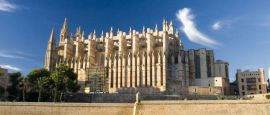Mallorca History, Language and Culture
History of Mallorca
Owing to its central location on the ancient Mediterranean trading route, the island of Mallorca has seen its share of conquerors, invaders and settlers over the centuries.
The first settlers are dated to at least 3000 BC, but this was small scale. Later the Greeks and the Phoenicians set up trading posts on the island, which then became part of the Carthaginian trading empire from North Africa. But it wasn’t until the Roman period that the island was settled in any great numbers.
In 123 BC the Romans conquered the island, and for almost 600 years Mallorca’s life and prosperity was intricately linked with Rome. Two main centres emerged, Pollentia (today Alcúdia) and Palma.
In the 5th century AD, Mallorca (and the other Balearic islands) were conquered by the Vandal Kingdom of Africa, who demolished much of the Roman infrastructure. In 534 AD the islands became part of the Byzantine Empire.
As the spread of Islam in the 7th century reached North Africa, the Moors conquered Spain and shortly after, the Balearics. Four hundred years of Arab dominance followed, and while they were eventually ousted by King Jaume I, who annexed the island to his Kingdom of Aragon (thus making Mallorca part of the Catalan empire), some of their influence still remains in local culture and tradition. A prosperous era followed, to which many of the island’s most important buildings, including Bellver Castle, the Almudaina Palace and the Convent of Sant Francese, owe their origins.
During the Spanish Civil War, Mallorca was attacked by the Republicans for being a nationalist stronghold. What became known as the Battle of Mallorca in August 1936 saw the nationalists ultimately succeed in defending the island.
Since the 1950s, Mallorca has been one of Europe’s first and most popular tourist destinations. Mass tourism throughout the following three decades saw Mallorca’s resorts boom, but it unfortunately got a reputation as a cheap, sun holiday for lager louts. A clean-up operation has seen the island enter a new phase of sophisticated tourism. Over 13 million tourists visit Mallorca each year.
Did you know?
• Mallorca is one of the world's most important training locations for professional cyclists.
• The name Mallorca comes from the Latin for 'larger one', as opposed to Minorca, the 'smaller one'
• Chopin, George Sand and Robert Graves all lived on Mallorca in the picturesque villages of Deia and Valldemossa.
Language in Mallorca
The official language is Catalan (spoken as the local dialect Mallorquín), although Spanish is of course also spoken by all residents. English and German are widely spoken in all tourist destinations, and most literature aimed at tourists can be found in these four languages as a minimum.




 You know where
You know where